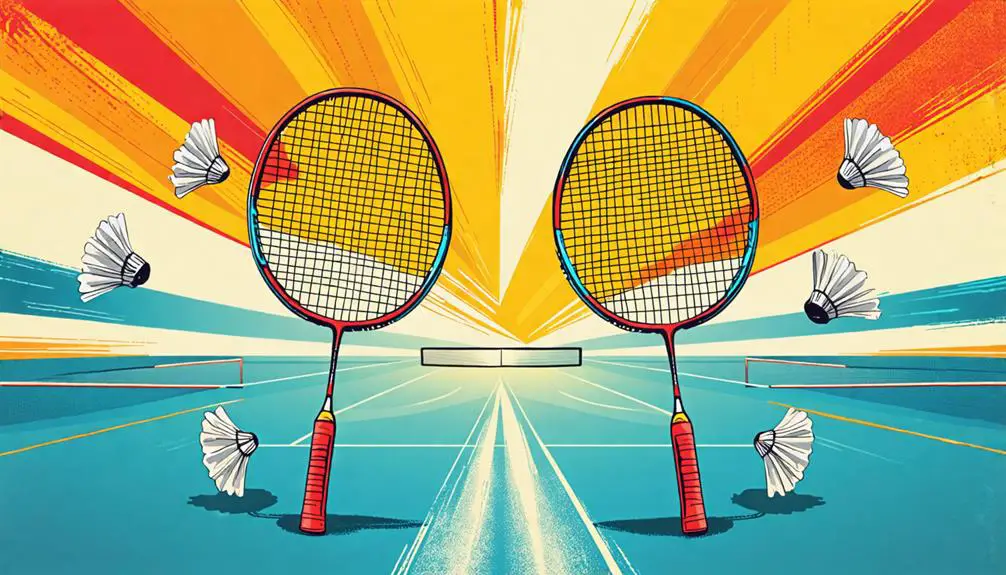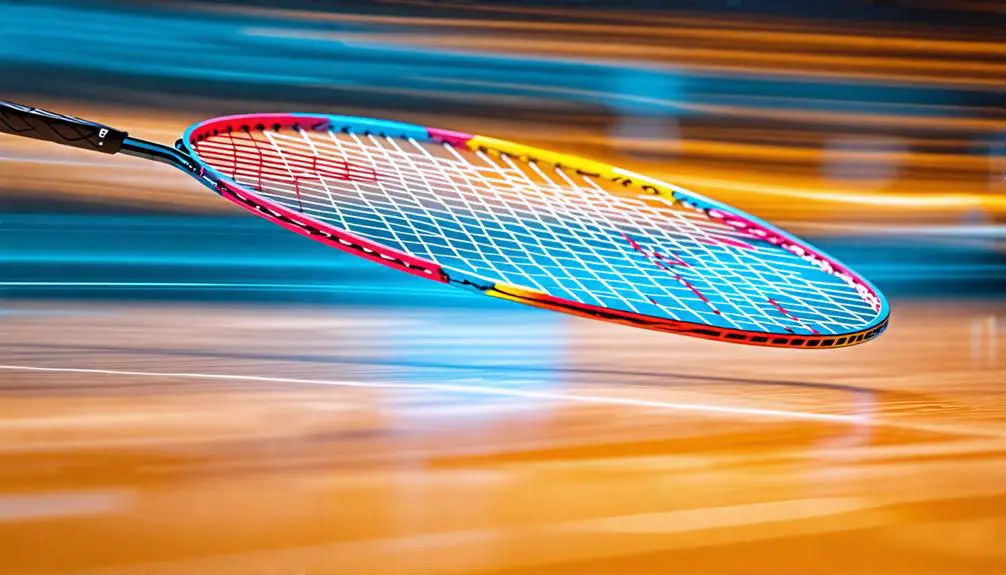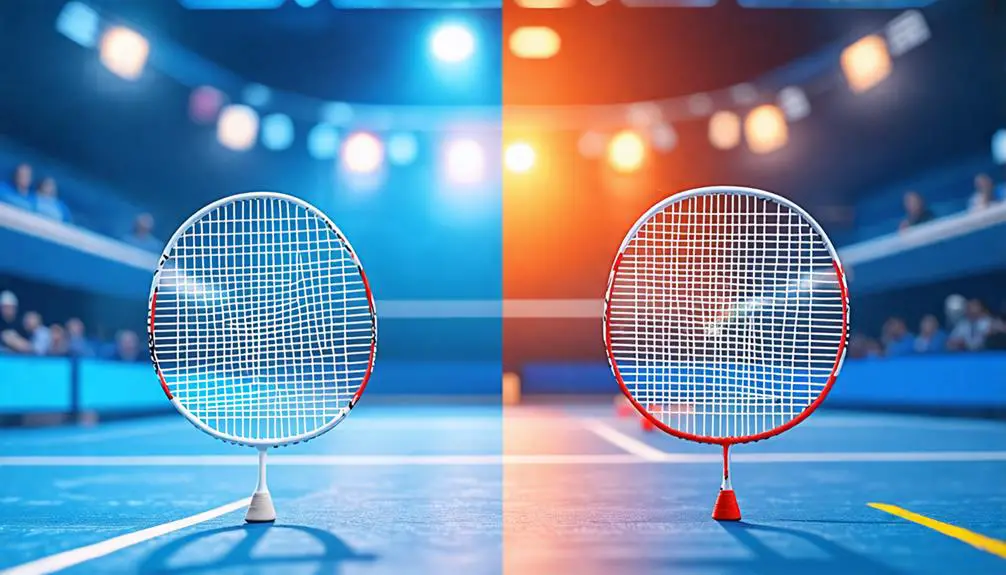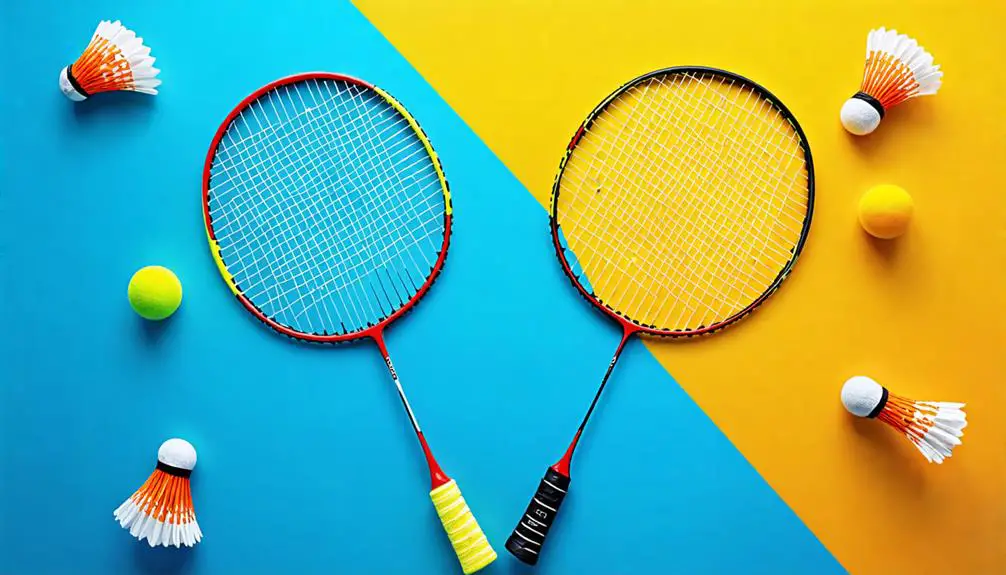When choosing between stiff and flexible badminton rackets, consider your skill level and playing style. Stiff rackets provide enhanced control and power, ideal for advanced players who possess solid technique. They generate maximum power but can lead to fatigue if not handled properly. On the other hand, flexible rackets offer forgiving playability, great for beginners, as they help generate power with less force and minimize injury risk. However, they may reduce shot precision. Understanding these differences helps you select the suitable option for your game, so you can outperform and enjoy every match even more.
Understanding Racket Flexibility

When selecting a badminton racket, understanding flexibility is important for optimizing your performance on the court. Racket flexibility, which refers to the bending ability of the racket shaft during impact, plays a vital role in how you execute shots. The flexibility of a racket can be categorized from extra stiff to flexible, each impacting your play differently.
If you're a beginner, you might find that a flexible racket enhances your stroke speed and provides added comfort, making it easier to develop your skills. On the other hand, if you're an advanced player, you may prefer a stiffer racket shaft. Stiff rackets typically offer better control and precision, which is essential for executing powerful smashes and strategic shots.
For recreational and intermediate players, a medium flexible racket provides a balanced option. This flexibility allows for both power and control, accommodating various playing styles. Understanding shaft stiffness is key here—extra stiff shafts favor aggressive players who prioritize power, while flexible shafts enable greater head movement, important for finesse shots.
Ultimately, selecting the right racket flexibility aligns with your playing style, strength, and skill level. By choosing a racket that complements your unique approach, you guarantee optimized performance on the court. Whether you're smashing hard or delicately placing the shuttlecock, knowing how flexibility affects your game allows you to play freely and effectively.
Characteristics of Stiff Rackets
Stiff badminton rackets are designed to cater to advanced players who prioritize shot accuracy and control. With a stiff shaft, these rackets exhibit minimal bending during impact, which greatly enhances shot precision. This characteristic makes them particularly suitable for players who demand better control over their gameplay and wish to execute tactical shots with confidence.
The construction of stiff rackets allows for maximum power generation with less flex. This means you can release powerful smashes and clears effectively, making them ideal for aggressive playing styles. However, it is important to note that using a stiff racket requires good technique and quick arm speed. Without these skills, you might struggle to optimize performance and achieve the desired power levels.
While stiff rackets offer numerous advantages, they can lead to increased fatigue if you don't employ proper technique. The demand for greater physical strength and control can be taxing, especially during prolonged play sessions. As a result, it is vital to guarantee you're physically prepared to handle the rigors of using a stiff racket.
For players moving from medium flexible options, stiff rackets are often favored as they provide superior precision and responsiveness. Elite players particularly appreciate this aspect, as it allows them to execute complex shots in competitive scenarios effectively. Overall, if you're looking to elevate your game and embrace a more tactical approach, investing in a stiff badminton racket could be a significant step in your badminton journey.
Characteristics of Flexible Rackets

Flexible badminton rackets are engineered to accommodate players who may not yet possess advanced skills, offering significant advantages regarding playability and comfort. One of the primary characteristics of these rackets is their higher bending capacity. This flexibility allows increased head movement during shots, which is particularly beneficial for generating power, especially for less experienced players.
Beginners and youth players find that flexible rackets provide a more forgiving experience on mis-hits, enhancing overall playability. The generous flexibility in the shaft reduces the risk of injury by minimizing the force exerted on the arm during strikes, making them a safer option for those still developing their technique.
Additionally, flexible rackets support defensive play styles, allowing for quicker reactions and improved control in shot placement during rallies. The adaptability of these rackets means you can engage in strategic gameplay without feeling restricted. They are also an ideal shift option for players moving from flexible to stiffer rackets, striking a balance between power and control.
In essence, the characteristics of flexible badminton rackets cater to a wide range of players, providing a user-friendly experience that encourages skill development while maintaining safety. If you're looking to enhance your game without sacrificing comfort, considering a flexible badminton racket could be a wise choice. Embrace the flexibility these rackets offer, and you might just find your gameplay improving faster than you expected.
Advantages of Stiff Rackets
For players who have developed their skills and seek to elevate their game, stiff badminton rackets offer several advantages that cater to advanced playstyles. These rackets are specifically engineered to enhance your performance, particularly if you focus on aggressive tactics. Here are some key benefits:
- Enhanced Control and Precision: Stiff rackets provide greater accuracy in shot placement, vital for competitive play where every point counts.
- Maximum Power Generation: With minimal flex, these rackets allow you to generate notable power in your smashes and clears, essential for overpowering your opponents.
- Support for Hard-Hitting Capabilities: The stiff shaft design accommodates players adapting from medium flexible shafts, greatly increasing your smash power.
- Suitability for Strong Arms: If you've got good technique and quick arm speed, a stiff racket can complement your natural abilities, allowing you to play effectively at higher intensities.
However, it's worth noting that stiff rackets require proper technique to avoid fatigue, emphasizing the need for practice and skill development. Mastering these rackets can lead to a more dynamic game, allowing you to explore your full potential on the court. Choose a stiff racket if you're ready to commit to an aggressive style and are equipped to handle the demands they present. By doing so, you'll find that your gameplay can reach new heights, making the most of your strength and skill.
Advantages of Flexible Rackets

When you opt for a flexible badminton racket, you'll find enhanced comfort during play, which can greatly improve your overall experience. This design also allows for increased reaction time, making it easier to respond to fast-paced shots. Additionally, the forgiving nature of these rackets reduces the risk of injury, particularly for players still developing their skills and strength.
Enhanced Comfort During Play
A flexible badminton racket can greatly enhance your comfort during play, particularly if you're a beginner or recreational player. The design of these rackets offers several advantages that contribute to a more enjoyable experience on the court:
- Less Force Required: Flexible rackets require less force to generate power, making it easier for you to hit the shuttlecock effectively without straining your body.
- Improved Defense: The longer bending moment aids in smash defense, enabling you to react more comfortably to powerful shots, enhancing your overall gameplay.
- Reduced Vibrations: With a flexible shaft, you'll experience less vibration upon impact, resulting in a more comfortable feel and minimizing strain on your arm.
- Forgiving on Mis-hits: Flexible rackets are particularly forgiving on mis-hits, boosting your confidence as you develop your technique without the fear of making mistakes.
Increased Reaction Time
How can a flexible badminton racket substantially boost your reaction time on the court? The design of a flexible shaft allows for quicker head movement, enabling you to execute shots faster. This enhanced reactivity is particularly beneficial during intense rallies, as it helps you respond more effectively to aggressive shots. The longer bending moment in flexible rackets contributes to improved smash defense, allowing you to adapt swiftly.
Moreover, flexible shafts require less force to generate power, enabling you to focus on timing and placement instead of exerting sheer strength. This shift not only aids in quicker reactions but also fosters greater consistency in your strokes. When mis-hits occur, the forgiving nature of flexible rackets helps maintain your confidence, leading to faster adjustments during gameplay.
Here's a quick overview of the advantages:
| Advantages | Details |
|---|---|
| Quicker head movement | Facilitates faster shot execution |
| Improved smash defense | Enhances response to aggressive shots |
| Lower force requirement | Allows focus on timing and placement |
| Increased consistency | Maintains confidence, leading to faster adjustments |
Reduced Injury Risk
While flexible badminton rackets offer numerous advantages on the court, one of the most significant benefits is their potential to reduce the risk of injury. For players, especially beginners and youth, using a flexible racket can help you avoid injuries that often arise from improper technique and overexertion. Here are some key ways flexible rackets can help you stay safe:
- Less Force Required: Flexible rackets need less physical force to hit effective shots, minimizing strain on your joints and muscles.
- Energy Efficiency: Their energy-saving properties allow for longer playing sessions without excessive fatigue, leading to a more comfortable experience.
- Vibration Absorption: The flexible shaft absorbs vibrations during impact, which reduces discomfort and potential injuries from repetitive strokes.
- Technique Support: For inexperienced players, these rackets offer a more forgiving option that encourages proper technique rather than reliance on raw power.
As you shift to a stiffer racket, it's essential to do this gradually. This approach helps you adapt your technique and strength safely, further contributing to your overall injury prevention.
Disadvantages of Stiff Rackets
Stiff badminton rackets, often favored for their power and responsiveness, come with several notable disadvantages that can hinder a player's performance. For many badminton players, especially beginners, stiff shafts can lead to reduced control and power. If you haven't developed the necessary technique, you might struggle to harness the potential of a stiff racket, making it less ideal for your early development.
Moreover, the vibrations generated during play can negatively affect your overall comfort and performance. If you're not accustomed to the rigidity, these vibrations can be distracting and lead to a loss of focus. When you execute powerful strokes, you may find that stiff rackets feel slow and unresponsive, which can disrupt your rhythm in quick-paced games.
Advanced players are not immune to the pitfalls of stiff rackets either. By relying too heavily on the racket's rigidity, you risk developing poor technique. This over-reliance could result in long-term performance issues, as your muscle memory might become conditioned to a specific style that doesn't translate to flexibility in movement.
Disadvantages of Flexible Rackets

Flexible rackets can be appealing for their lightweight design and ease of maneuverability, but they come with distinct drawbacks that may impact your game. While flexibility can enhance certain aspects of play, it often compromises control and precision, particularly for advanced players. Here are four key disadvantages you should consider:
- Reduced Control: The inherent flexibility of these rackets can lead to a lack of precision in shot placement, making it harder to execute targeted plays.
- Vibrations and Discomfort: Flexible rackets tend to transmit more vibrations upon impact, which can distract you and affect your performance, ultimately leading to discomfort during longer matches.
- Slower Response Time: When you're trying to make powerful strokes, the flex in the racket may cause it to feel slow and unresponsive, making aggressive plays more challenging to execute effectively.
- Technique Development Issues: Over-reliance on flexibility can encourage poor habits, as you might compensate for the lack of stiffness with incorrect techniques, which could hinder your overall skill growth.
In quick-paced games where precision is paramount, flexible rackets can hinder your ability to make rapid, controlled shots. Balancing flexibility with control is essential for optimizing your performance, so consider these drawbacks before committing to a flexible racket. The right choice can greatly influence your game strategy and effectiveness on the court.
Transitioning Between Flexibilities
When shifting between racket flexibilities, it's essential to approach changes gradually to prevent injury and adapt effectively. You should assess your personal playing style and comfort, as these factors greatly influence how well you can perform with a new racket type. Familiarizing yourself with different flex options through regular practice will enhance your skill set and help you adjust more smoothly over time.
Gradual Flex Transition Techniques
Shifting between racket flexibilities requires careful consideration and a methodical approach to guarantee peak performance while minimizing the risk of injury. To successfully shift between flexibilities, follow these techniques:
- Familiarization: Before you choose a racket, spend time with your current one. This familiarity will help you adapt your techniques effectively.
- Incremental Testing: Experiment with various flex options gradually. This allows you to gauge the differences in performance and control without overwhelming your skills.
- Assess Arm Health: Consider your physical capabilities and arm health. Verify that the stiffness of your new racket complements your playing style to avoid strain.
- Seek Guidance: Don't hesitate to consult experienced players or coaches. Their insights can provide essential support during your shift, enhancing your overall gameplay adaptation.
Assessing Personal Playing Style
Evaluating your personal playing style is essential for successfully changing between racket flexibilities. Understanding your strengths and techniques can guide you in choosing the right racket for best performance. Advanced players who can generate power and control often benefit from stiff rackets, while those with less experience might find flexibility more forgiving.
| Racket Flexibility | Ideal For | Change Tips |
|---|---|---|
| Flexible | Beginners/Intermediate | Gradual change to avoid injury |
| Medium Flexible | Intermediate | Balance between power and control |
| Stiff | Advanced | Requires good arm speed and precision |
As you assess your playing style, consider how often you use flexible rackets. Incorporating medium flexible options can help ease the change, allowing for a more gradual adjustment. It's also wise to seek advice from experienced players or coaches. They can provide insights tailored to your playing style, ensuring you make informed decisions about racket flexibility. Remember, each change should be approached carefully to maintain performance and reduce the risk of injury.
Importance of Familiarity
The importance of familiarity in shifting between racket flexibilities cannot be overstated. When you switch between flexible and stiff rackets, it's crucial to approach the change with care to maintain your performance and prevent injury. Here are four key points to reflect on:
- Gradual Adjustments: Sudden shifts in racket flexibility can strain muscles and joints. Take your time to acclimate to a new racket type.
- Assess Arm Health: Before making any changes, evaluate your arm health and playing technique. This assessment can greatly impact your performance.
- Consult Experienced Players: Engaging with seasoned players or coaches can offer valuable insights, helping you navigate the complexities of shifting between flexibilities.
- Regular Practice: Continuously practicing with different racket flexibilities enhances your adaptability, ensuring you're ready to utilize your chosen racket effectively during matches.
Familiarity with your current racket type not only boosts your comfort but also enhances your overall performance. Embracing these principles will empower you to make informed shifts, allowing you to enjoy the freedom and versatility that come with mastering various racket flexibilities.
Choosing the Right Racket

Choosing the right badminton racket is vital for optimizing your performance on the court. Your skill level is a key factor; if you're a beginner, a flexible racket can enhance comfort and ease of handling, making it easier to develop your technique. In contrast, advanced players often gravitate toward stiffer rackets that offer greater control and power, allowing for precision shots.
The balance point of the racket also plays an important role in your gameplay. A head-heavy racket can provide an advantage for powerful smashes, while a head-light racket improves maneuverability, ideal for fast-paced rallies. Understanding how these balance points affect your style can greatly enhance your performance.
Grip size matters more than you might think. Selecting the right grip size, typically ranging from G2 to G5 in Japan, guarantees better handling and control, reducing the risk of injury during intense play.
Additionally, consider the weight of the racket. Lighter rackets, weighing under 80 grams, allow for quicker swings, which can be advantageous in fast exchanges. However, heavier rackets can deliver more power but may lead to muscle strain over extended play.
Ultimately, testing various rackets is essential. Your individual preferences in flexibility, weight, grip, and balance will greatly influence your playing style. Taking the time to experiment with different rackets will help you make an informed decision that enhances your game.
Frequently Asked Questions
Is a Stiff or Flexible Badminton Racket Better?
When considering whether a stiff or flexible badminton racket is better, it really depends on your playing style and skill level. A stiff racket excels in power generation and shot control, making it ideal for advanced players who can handle its demands. Conversely, a flexible racket offers more forgiveness and can aid beginners in developing technique. Ultimately, you should assess your comfort, technique, and the style of play you wish to enhance before choosing.
What Is the Difference Between Stiff and Flexible Racquets?
The difference between stiff and flexible rackets lies primarily in racket performance and player preference. Stiff rackets offer superior control and precision, making them ideal for advanced players who favor accuracy. In contrast, flexible rackets enhance power generation and comfort, benefiting beginners and those developing their technique. Ultimately, your choice should reflect your playing style, as it can greatly impact your overall game experience and effectiveness on the court.
Is a Stiff Shaft Better Than Regular Badminton?
"You can't make an omelet without breaking eggs." When considering whether a stiff shaft is better than a regular badminton racket, it depends on your playing style and strength. A stiff shaft offers superior power generation and control, ideal for advanced players. However, if you're still developing your technique, a flexible racket might be more forgiving. Ultimately, choose the one that aligns with your skills to enhance your performance while minimizing the risk of injury.
What Is the Advantage of a Stiff Racket?
When you use a stiff racket, you gain significant advantages in power generation and shot precision. The extra stiffness allows you to execute your shots with greater accuracy, making it easier to place the shuttle exactly where you want it. This control is essential for aggressive play styles. However, remember that using a stiff racket requires well-developed techniques, as improper use can lead to fatigue, limiting your performance on the court.




